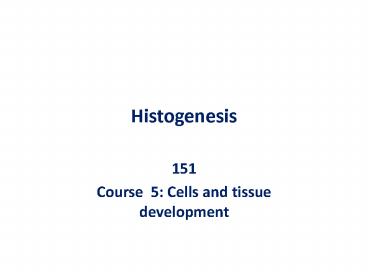Histogenesis - PowerPoint PPT Presentation
1 / 33
Title:
Histogenesis
Description:
... mesenchymal cell mesenchymal cell chondroblast lipoblast fibroblast osteoblast myoblast ... paraxial mesoderm Segmentation: Notch, WNT, segmentation ... – PowerPoint PPT presentation
Number of Views:536
Avg rating:3.0/5.0
Title: Histogenesis
1
Histogenesis
- 151
- Course 5 Cells and tissue development
2
Course 5 Development
- 137 Case report Thalidomide
- 138 Basic morphogenetic processes
- 139 Regeneration and reparation
- 140 Female reproductive system
- 142 Gametogenesis and fertilization
- 144 Genetic determination of the sex
- 145 Signalization in development
- 146 Blastogenesis, notogenesis
- 149 Notogenesis, neurulation
- 150 Embryonic period
- 151 Histogenesis
- 152 Human reproductive genetics
- 153 Developmental toxicology
- 154 Ageing
- 141 Female reproductive system
- 143 Male reproductive system
- 147 Extraembryonic organs
- 148 Early embryonic development, chick
3
Aim
- histogenesis the origin and development of
specialised tissues and organs the derivates
of - ectoderm
- mesoderm
- endoderm
4
blastogenesis
embryonic period
Histogenesis, organogenesis
fetal period
5
Ontogenesis
- mechanisms operateat different levels
- cells - differentiation
- cell populations - morphogenesis - structure
development - cell populations set - morphogenetic system
realizes structure and function programme in
organ or part of the body basic morphogenetic
processes
6
1. Cell level differentiation mesenchymal cell
mesenchymal cell
chondroblast
lipoblast
fibroblast
osteoblast
myoblast
cartilage
fat
bone
muscle
hemocytoblast
connective tissue, ligaments, tendons
endothelium blood cells
7
Cell level differentiation neuroepithelim
8
2. Cell populations level
- development of structures/ organs - morphogenesis
- 1. induction one cell population induces the
change of the fate in another cell population - epithelial-mesenchymal interactions
- examples limbs, lens, nephrons, teeth
- cross-talk
- 2. cell-signalling, signalising cell x target
cell (must be sensitive to this signal) - paracrine interactions, contact interactions
9
- induction neuroectoderm / surface ectoderm lens
placode
10
Induction in gonad indifferent stageinduction
primordial germ cells/ testes, ovaryinduction
coelomic epithelium / mesenchyme
11
3. Morphogenetic systems level group of cell
populations relize the developmental programme
- basic morphogenetic processes - 4 processes play
out at the cell population level to essentially
create the final organism - proliferation
- migration
- asociation
- programmed cell death - apoptosis
12
Morphogenetic system level neural tube
differentiation in CNS development
13
Histogenesis
- EPIBLAST is the maternal of 3 germ layers
- ectoderm and endoderm are epithelia
- Expression CAM
- mesoderm is connective tissue primary
mesenchyme - No Expression CAM -
14
Origin of 3 germ layers
15
Germ layers derivates
- nervous systeme
- senses
connectives - skin
circulatory s. -
hematopoesis, -
immune s. -
endocrine s.
Epiblast
mesoderm
ectoderm
endoderm
digestive s. respiratory s
urogenital sytem
mesenchyme
16
Ectoderm and its differentiation1.neuroectoderm
(neural tube a neural crest)2. surface ectoderm
1.neuroectoderm
2. surface ectoderm
neuroectoderm NT, neural crest placodes surface
ectoderm epidermis
17
Neural tube region of the future brain
(segmentation- neuromers- brain vesicles)
18
- induction neuroectoderm / surface ectoderm
- placodes - otic placodes and lens placodes
19
Neuroectoderm - neural crest definitive
derivates
connectives, cartilage, bone, dermis of the head
cranial nerves ganglia
odontoblasts, Schwann cells melanocytes, C-cells
of thyroid autonomic ganglia
adrenal medulla
20
Ectoderm derivates mediate the contact between
body and outer environment
- CNS
- PNS
- sensory epithelium of the ear, nose, eye
- epidermis and its derivates hairs, nails
- glands of the skin, mammary gland
- hypophysis
- enamel
21
Endoderm and its differentiation yolk sac roof
and wall, primitive gut
22
Endoderm-lined cavity and its position during
cephalo-caudal folding
sagittal midline section
23
Endoderm and its derivates
- gastrointestinal tract epithelium
- respiratory sytem epithelium
- parenchyme of the liver, pancreas, thyroid
- reticular stroma of tonsils and thymus
- epithelium of salivary glands
- epithelium of urinary bladder, urethra
- epitel of middle ear and Eustachian tube
24
Mesoderm and its early differentiationaxial,
paraxial, intermediate, lateral
25
Mesoderm mesenchyme embryonic connective
tissue
26
Somite differentiationsclerotome, dermatome,
myotome
sclerotome connectives coating spinal cord
epiteloid arrangement of somite
dorsolateral cells migrate to the limb bud -
muscles
Dorsomedial cells myotome trunk muscles
dorsally - dermatom beneath ectoderm dermis
in the skin
27
Somites, 42 44 pairs . 1.pair in occipital
region, 20EDMaterial paraxial
mesodermSegmentation Notch, WNT, segmentation
genesRetinoic acid, FGF8, cranio-caudal
gradientS
28
Intermediate mesoderm derivatesurogenital
sytemin cervical, and thoracal region
segmented in nephrotomesabdominal nefrogenic
blastema
29
Excretory units of kidney and gonad primordium
30
Lateral mesoderm splanchnic/ splanchnopleura
and somatic/ somatopleura
31
splanchnopleura wall of gut (CT,
muscle)somatopleura serous membrane inner
lining of coelom
transversal section
3week
4week
32
Mesoderm and its derivates
- connectives (connective tissue proper, cartilage,
bone) - blood
- mesothel and endothel the only epithelia
- kidneys
- gonads
- mesothel simple squamous epithel of the
visceral peritoneum /splanchnopleura in
peritoneal cavity
33
Tissues family tree

